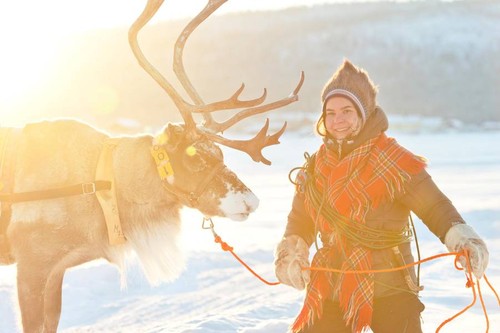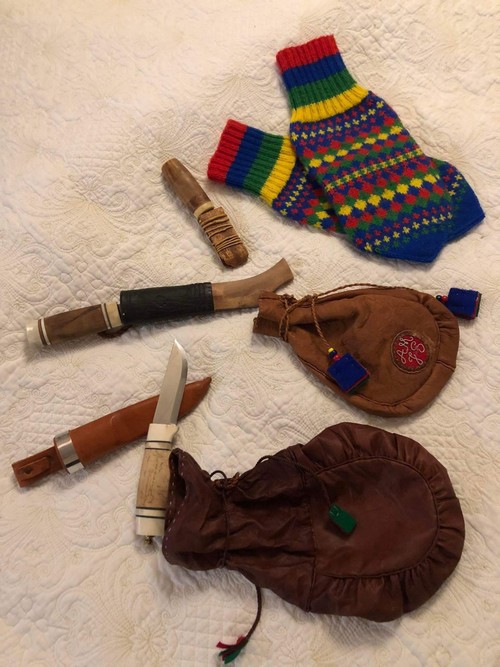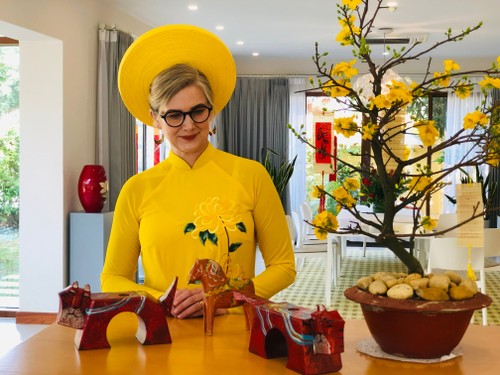 Reindeer are a central element of how the Sami live their lives. (Photo: visitsweden.com) Reindeer are a central element of how the Sami live their lives. (Photo: visitsweden.com) |
Bao Tram: Thank you, Ambassador Ann Måwe, for joining us on the first Cultural Rendezvous show of the Lunar New Year. Happy New Year! All the best to you and your family in the Year of the Tiger!
Ms. Ambassador: Thank you so much. Let me send the greeting in such a wonderful celebration. I really hope all your listeners have had a great holiday and I wish them all the best for the coming year - good health, success, and happiness - and not least with a focus on health and recovery in this difficult year caused by the COVID-19 pandemic.
Bao Tram: I just watched “Frozen”, an American computer-animated musical fantasy film from Walt Disney Animation Studios. You probably know this film. I heard that the film’s music, in particular the opening song called “Song of the Earth”, is based on the folk music of the Sami, an official ethnic minority in Sweden. Who are the Sami, and what can you tell us about their culture and history?
Ms. Ambassador: The Sami people are indigenous people, the original people in the north of the Nordic countries. They live in the north of Sweden, Norway, Finland, and Russia in a land called Sápmi. They are nomadic or semi-nomadic people, which means they move around from season to season. So national borders are not important to them because they follow the reindeer, and the reindeer is very important in the Sami culture. In the summer, they move up into the mountains with them. In the winter, they move to the lowlands. It depends on the weather.
The Sami have a very strong culture. The Sami language is very different from Swedish. There are many branches of the language but different Sami groups can talk to each other. They have a very strong traditional handicraft. They used to have their own religion and so on. So it is a strong culture!
Bao Tram: Raising reindeer is a central part of the Sami culture, I understand. What can you tell us about their reindeer herding?
Ms. Ambassador: Well, you know, I grew up in the north of Sweden and often went up into the mountains to hike with my family when I was young. There are many things that strike you when you meet Sami people. Some of them still live in the traditional way, herding the reindeer. I think reindeer are central to understanding the Sami culture. For them, the reindeer is food. Their handicraft items are made from the skin and horns of the reindeer. I think there are about 260,000 reindeer in Sweden. They belong to different Sami families and villages. Reindeer are the first thing you think about when you think about Sami culture.
 Three knives with reindeer horn and wood handles, two reindeer leather bags for storing coffee or sugar on the mountain, typical Sami style wool mittens from Jokkmokk (Photo by Ambassador Ann Måwe) Three knives with reindeer horn and wood handles, two reindeer leather bags for storing coffee or sugar on the mountain, typical Sami style wool mittens from Jokkmokk (Photo by Ambassador Ann Måwe) |
Bao Tram: What do you know about the Sami handicraft called “duodji”?
Ms. Ambassador: Their handicraft, which is very elaborate, very beautiful, includes functional things like knives or bags that you can carry food or coffee or something like that in, made of leather from the reindeer, and beautifully decorated. Very beautiful jewelry that used to go with the traditional costumes of the Sami people. Their tradition lives on. Young people are learning the old ways of making handicraft items, but now they’re also exploring ways to modernize it. And, of course, tourists who come to the area buy the handicrafts as souvenirs of the northern Nordic region.
Bao Tram: A joik or yoik is a native Sami musical form. I understand there are some Sami joik artists who are popular on YouTube. Tell us what you know about this form of music and its popularity in Sweden.
Ms. Ambassador: There are many aspects I'm a little bit uncomfortable speaking about it, because I'm not a Sami myself. So I can’t really speak to the meaning of their culture. But they have a very traditional way of singing. It's called joik. This is a traditional song, often about a person or an animal or something in nature. Joiks are personal and are passed down from generation to generation. So I think this is also a very important feature of the culture. And what you see today is young artists in Sweden, pop artists or hip hop rap artists, who are using the joiks and reinterpreting the Sami heritage by making modern music based on traditional joiks.
 Swedish Ambassador Ann Måwe in the Vietnamese traditional long dress, Ao Dai, ahead of the Lunar New Year 2022 (Photo credit: Swedish Embassy) Swedish Ambassador Ann Måwe in the Vietnamese traditional long dress, Ao Dai, ahead of the Lunar New Year 2022 (Photo credit: Swedish Embassy)
|
Bao Tram: Do you think the Sami can integrate without losing their own culture?
Ms. Ambassador: They have their own culture, their own cultural expressions. They have a parliament. I think what’s interesting about the Sami population today is that many young Samis have been fully integrated into Swedish society, but they want to understand their roots and their culture. So you have many cultural expressions in music, in art, and in literature where young Samis are exploring their roots, their history, their culture, but in a modern way and kind of re-defining their culture and their language.
Bao Tram: What role do the Sami play in Swedish society?
Ms. Ambassador: Today the Sami are a national minority in Sweden. They have their own language. There are schools in the Sami language now with Sami curricula. There has been a parliament for the Sami people since the early nineties in Sweden and also in Norway and Finland. They have their own flag and many national expressions.
Bao Tram: Thank you so much, Ms. Ambassador, for joining VOV’s Cultural Rendezvous today and sharing with us some interesting information about the Sami.
Ms. Ambassador: Thank you! I hope one day to have a delegation with somebody who represents the Sami and the Sami culture, because I think there might be things in common between the ethnic minorities in Vietnam and the Sami people in terms of cultural and historic experiences that could make it useful to have an exchange.